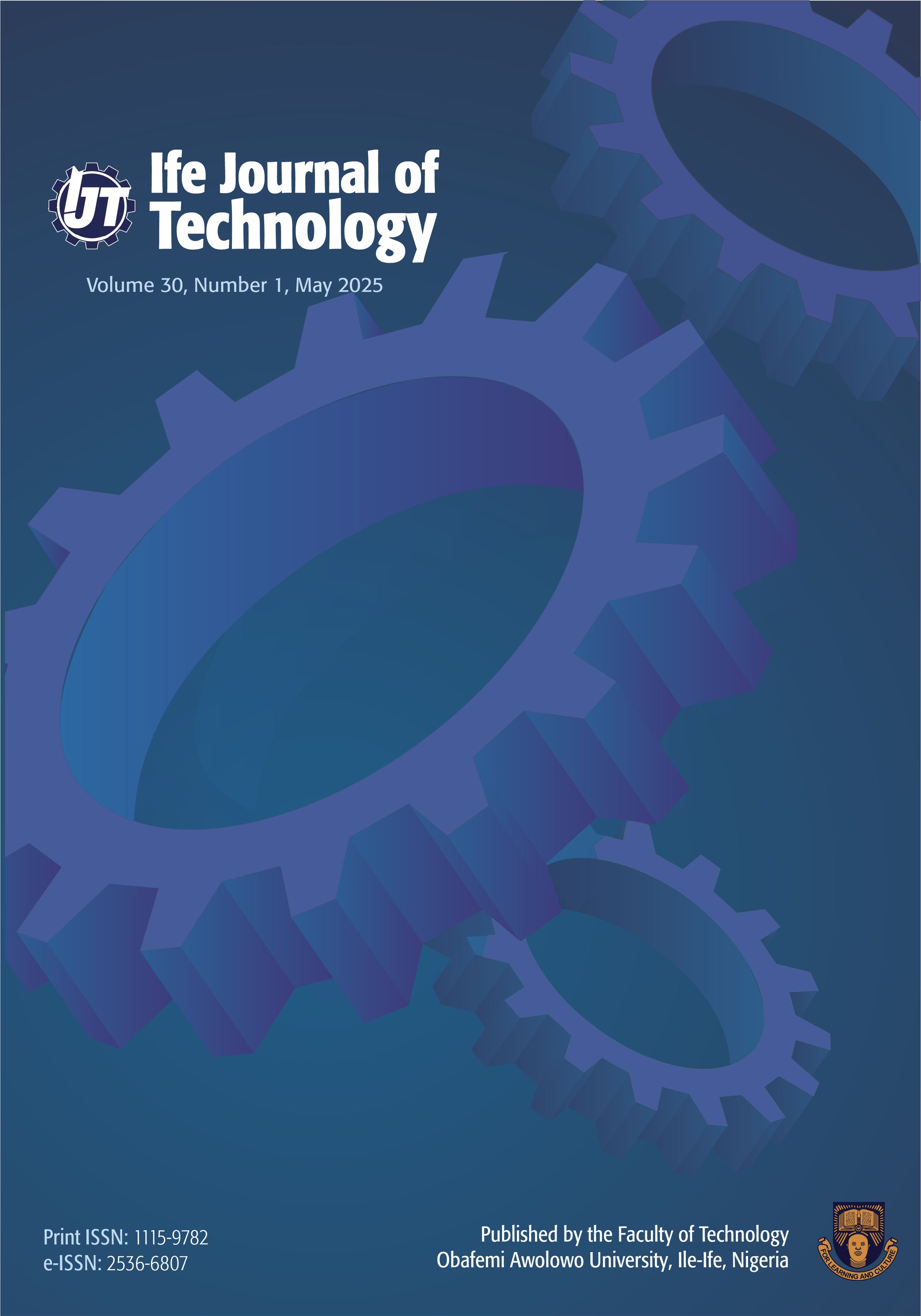Optimizing Worker Safety: Modelling Age, Exposure Duration and Noise Effects on Hearing Threshold in Quarry Workers
Abstract
Quarries play a vital role in the construction industry. However, studies indicate that the age of quarry workers and their years of exposure to quarry activities contribute to hearing issues. Data on the effects of noise and related factors on hearing damage among Nigerian quarry workers are limited. This study aimed to investigate the effect of age, exposure duration, and noise levels in quarries on workers' hearing thresholds. In 2022, 204 quarry workers aged 18 to 65 were randomly selected from four quarries in the southwestern Nigeria. A follow-up study in 2023 included 185 workers. Questionnaires captured their age and exposure years, while digital sound level meter was used to measure noise levels. Hearing thresholds were tested at eight frequencies (250 Hz to 8 kHz) using an audiogram. Eight regression models were developed using response surface methodology to predict the effects of age, exposure, and noise on hearing thresholds. Noise levels at the quarries ranged from 87.3 to 116.98 dB(A), exceeding the permissible 85 dB(A) limit. The models predicted R² values between 0.71 and 0.82. Safe hearing thresholds were predicted for the workers aged ≤52 years and with ≤32 years of exposure. The models showed strong predictability, making them useful for planning recruitment and operational policies in the quarry industry. It was concluded that age, exposure duration, and noise levels significantly affect quarry workers' hearing thresholds.
References
Abdulkadir, S.J., Alhussain, H. and Nazmi, M. 2018. Long short term memory recurrent network for standard and poor’s 500 index. Modelling 7.4: 25-29.
Akanbi, O. G. and Oriolowo, K. T. 2016. Modeling the prevention of transformation of pressbycusis to noise induced hearing loss. Journal of NIIE 6: 47-58.
Akanbi, O. G., Oriolowo, K. T., Oladejo, K. A., Abu, R., Mogbojuri, A. O. and Ogunlana, R. 2021. Models for estimating the hearing threshold of quarry workers at high frequencies. Nigerian Journal of Environmental Sciences and Technology 5.1: 140- 151.
Amirian, M. 2019. Mitigating sub-synchronous resonance using static var compesator (SVC) enhanced with adaptive neuro-fuzzy inference systems (ANFIS) controller. Proceedings of 27th Iranian Conference on Electrical Engineering (ICEE). 532-538.
Asfahl, C. R. 2004. Industrial Safety and Health Management. 5th ed. Pearson Prentice Hall: Upper Saddle River.
Aslan, Z. Erdemir, G., Feoli, E., Giorgi, F. and Okcu, D.J.P. 2019. Effects of climate change on soil erosion risk assessed by clustering and artificial neural network. Geophysics 176 .2: 937-949.
England, B. and Larsen, J. B. 2014. Noise levels among spectators at an intercollegiate sporting event. Am J Audiol 23.1: 71-78.
Ghimire, N., Thakur, S.K., Jha, A.K., Yadav, R. and Mukhopadhyay, S. 2019. Screening of hearing ability and hearing threshold among traffic police. Asian Journal of Medical Sciences.10.5: 49-53.
Gyanfi, R.K.C., Amankwa, I., Sekyere, O.F. and Boateng, D. 2016. Noise exposure and hearing capabilities of Quarry workers in Ghana: A Cross-sectional study. Journal of Environmental and Public Health. Article ID 7054276. Retrieved Nov. 27, 2018, from http://dx.doi.org/10.1155/2016/7054276.
Healthy hearing.com. 2020. Understanding the degrees of hearing loss and hearing losss levels. Retrieved Jan. 3, 2022, from https: // www.healthyhearing.com/report/41775- Degrees- of- hearing-loss.
Howard, J. H., Robert, A. D., Katalin, G. L., Christa, L., Themann, M. A. and Gregory, A. F. 2017. Declining prevalence of hearing loss in US Adults aged 20 to 69 years. JAMA Otolaryngol Head Neck Surg 143.3: 274-285.
Ilse, M., Tomczak, J.M., Tomczak and Welling. 2020. Deep multiple instance learning for digital Histopathology. Handbook of medical image computing and computer assisted intervention. Elsevier 521-546.
Industrial Accident Prevention Association (IAPA). 2008. Hearing conservation. Retrieved Sept. 19, 2013 from www.iapa.ca.2hearing.
Ismail, A. E., Daud, A., Ismail, Z. and Abdullah, B. 2013. Noise induced hearing loss among quarry workers in a North-Eastern state of Malaysia : a study on knowledge, attitude and practice. Oman Medical Journal 28.5: 331-336.
Karaboga, D and Kaya, E. 2018. Adaptive Network Based Fuzzy Inference System (ANFIS) training approaches: a comprehensive survey. Artif Intell Rev 1-31.
Kerketta, S., Gartia, R. and Bagh, S. 2016. Assessment of noise induced hearing loss of the mine workers of Chromite mines at Sukinda, Odisha, India. ENVIS Bulletin Himalayan Eccology 24:60-68.
Kisi, O., Shiri, J., Karimi, S. and Adnan, R.M. 2018. Three different adaptive neuro fuzzy computing techniques for forecasting long period daily streamflows. Big Data in Engineering Applications. Springer. Singapore. 303-321.
Lobarinas, E., Salvi, R. and Ding, D. 2013. Insensitivity of the audiogram to carbon plating induced inner hair cells loss in Chinchillas. Hear Res 302: 113-120. Retrieved Jun 17, 2018, from https://doi.org/10.1016/j.hears.2013.03.012
Math Works. Design and Simulate fuzzy logic systems. 2017. Accessed Nov. 24, 2019, from www.mathworks.com.
Neuman, W. L. 2007. Basics of social research: Qualitative and quantitative approaches. 2nd ed. Boston, M.A. : Allyn and Bacon.
Nordstokke, D.W and Colp, S.M. 2018. A note on the assumption of identical distribution for non-parametric test of location. Practical Assessment Research and Evaluation 23.3: 1-9.
Ojolo, S. J. and Ismail, S. O. 2011. Mathematical modeling of effects of noise on machine operators. Proceeding of International Conference on Innovation in Engineering and Technology. 78 – 90.
Oladapo, S.O. and Akanbi, O.G. 2015. Models for predicting body dimensions needed for furniture design of junior secondary school one to two Students. International Journal of Engineering and Science 4. 4: 23-36.
R Core Team. 2017. R: A language and environment for statistical computing. Vienna, Austria: R Foundation for Statistical Computing.
Shear, B.R., Nordstokke, D.W. and Zumbo, B.D. 2018. A note on using the non-parametric Levene test when population means are unequal. Practical Assessment, Research and Evaluation. 23.13. Retrieved Aug. 27, 2020, from https: //doi.org/10.7275/mg 59-xq60.
Shihabudheen, K.V. and Pillai, G.N. 2018. Recent advances in neuro-fuzzy system: a survey. Knowl-based Syst 152:136-162.
Talpur, N., Abdulkadir, S.J. and Hassan, M.H. 2020. A deep learning based neuro-fuzzy approach for solving classification problems. Proceedings of International Conference on Computational Intelligence (ICCI) Universiti Teknologi PETRONAS (UTP) 8th-9th October 2020.
World Health Organisation (WHO). 1991. Retrieved Feb 2, 2022 from http://www. who.int/iris/handle/10665/58839.


